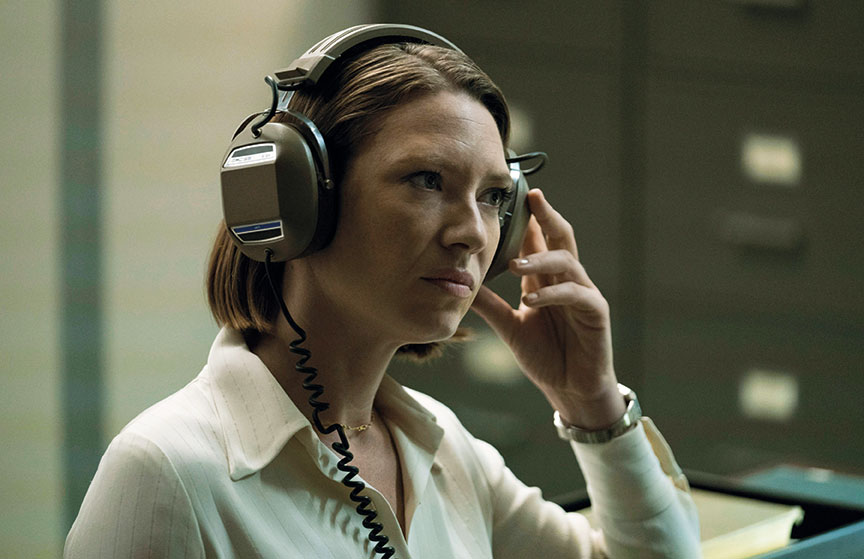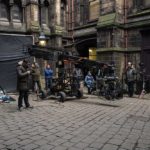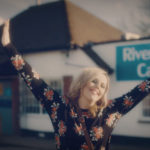
Thought Police – The Making of Mindhunter
Posted on Feb 6, 2018 by Julian Mitchell

Director David Fincher drove an era-defining aesthetic using the highest-end equipment. Definition spoke to cinematographer Erik Messerschmidt to find out how it influenced the huge Netflix hit, Mindhunter
Definition: Mindhunter seems to be a show that has some very strict guidelines for shooting (similar to House of Cards). I’m not sure if these disciplines are true but perhaps ‘no zooms’, ‘no steadicams’, ‘no handheld’, ‘no filtration’. Could you talk about the regime of shooting Mindhunter in these terms and why the practices are adhered to?
Erik Messerschmidt: I wouldn’t say that we necessarily approached Mindhunter in terms of what we wouldn’t do with the camera, but more in terms of what camera choices would support the story and themes of the show. It’s true (with the exception of two shots in Episode 10) that we didn’t use any handheld or Steadicam; most of the drama in Mindhunter comes from the characters’ experiences in very long and complex interview scenes. The content of those scenes is extremely measured and nuanced and I think a moving or shaking camera would have been a very distracting way to tell such a complex story. David Fincher likes a very specific type of operating; it harks back to the earlier days of classic cinema when the actors, dolly grip and operator are working together in concert to execute the shot. It’s a beautiful thing to watch. I feel like Steadicam, while an amazing and versatile tool, is often misused, or chosen because it’s a faster way to cover a scene.


Def: Could you tell us about the lens choices and how they translate to the action in the various sets and locations? The way you shoot is obviously linked to the talk-heavy nature of the series – very careful camera movement, careful jump focusing and so on. The lens choice doesn’t seem to be too fast nor the other way: it’s nice glass. Again, regimented use of a T-stop and a sweet spot of a focal length. If you use zooms, are they for specific reasons?
EM: We shot with Leica Summilux-C lenses living mostly on the 29mm, 40mm and 65mm focal lengths. Working with prime lenses is great because it requires a little more discipline than zooms. In the past I’ve found it very difficult to resist the temptation to push in a bit on the zoom instead of moving the camera when the shot isn’t perfect. Prime lenses force you to always keep the camera in the right place from the start, and restricting our lens choices keeps the storytelling very consistent, which I think is important on a show like this. I shot most of Mindhunter, at least the interiors, at a T2-2.8. The exteriors were typically around a T4 or T5.6. I like the way the Leicas look at a T2.3, it’s where I think they are their best. We tried to limit the audience’s awareness of the camera as much as possible, so if we did move it we only did so in very specific dramatic moments or when other things in the frame were also moving. I did use the Fujinon 24-180 and
75-400 zooms a couple of times on the show for specific shots, but never for zooming.

Def: Tell us more about the control that you have on set and locations, specifically the lighting in both. Is it a case of having more control in established sets, such as the Quantico office, and a particular shooting regime to handle new locations where control of windows and outside is less easy?
EM: I was fortunate on Mindhunter to have prep time with each director so we had lots of conversations about our location work before the shooting day. I was also incredibly blessed to be working with the amazing Steve Arnold, our production designer. Steve and I had a constant dialogue about practical lights, window treatments and wall colours. We were also blessed to have amazing locations department staff who deserve tremendous credit for their contribution to the show’s look. A lot of the scenes took multiple days to shoot, and our shooting day often extended past sundown so we papered a lot of windows. At first I was worried about that, but then after watching The Godfather and Chinatown again as references I realised how many of those interiors were cheated with blown-out windows, so I felt better about it!
The Quantico office is a stage set with green screen, so we had quite a bit more control over the light there.
Def: Please talk us through the lighting design. Apart from key or talent lights, it is obviously minimised to practical and natural light. Does the performance of the camera encourage this, are you pushing the ISO? What lights are you using, and how are you adjusting colour temperature?
EM: I would always prefer the natural light of a set to do the majority of the work, I just think it always looks better. Steve Arnold and I spent a lot of time talking about window locations and practical lights as they pertained to the blocking each director had in mind. There are always times when it’s necessary
to hang a light to get some separation, or use a bit more light in the eyes or whatever, but it was pretty minimal. I rated the camera at 640 ASA for a couple of reasons. One, I wanted to work predominately in the toe of the exposure range, so I felt like I needed to protect the shadows a bit more than the highlights. The second reason was that I deliberately wanted to work with a little more light than we might at 800 or 1000 ASA. In the past, I’ve found at 800 or 1000 ASA
I end up having to control the shadows so much more than I would like, so it can be a little hard to be expressive with the lighting. At 640 ASA I can still work at 10 to 25 foot-candles without polluting the entire scene with light. Its a nice, balanced place to start.
 Asif Kapadia, director of episodes three and four, with Erik (right) on the Mindhunter set.
Asif Kapadia, director of episodes three and four, with Erik (right) on the Mindhunter set.
Def: The look of Mindhunter is extremely mature – I heard that you took references from stills photographers such as Steve Shore and Mitch Epstein. How did they influence Mindhunter? Was it their take on the ‘real’ America of the 70s? Is the look couched in a generic desaturated LUT that is sacrosanct?
EM: Yes, I looked at a lot of photography. Steven Shore, Joel Sternfeld, Todd Hido and Mitch Epstein were all influential. I’ve said before that I don’t think production designers, set decorators and costume designers get enough credit for the way movies look. I was incredibly fortunate on Mindhunter to have real partners in crime in all those departments. David Fincher is involved in every visual decision in the show and he kept our pallete restricted to a very specific set of tones. The period is full of yellow, cyan, brown and avocado green. Those colours became our benchmark. When it came to the final colour grading we didn’t apply much of a cast or skew the colour, as much of the look is the result of thoughtful set design and costume choices.

Def: With the Xenomorph camera, how much does that help operating? I believe it is stripped down or has accessories as part of the design – can you explain the customisation?
EM: Fincher’s design philosophy behind the Xenomorph was to integrate all the standard accessories we typically add to a camera into the body so there are no excess wires or mounting hardware. I think anytime the camera is simplified it helps everyone, and the Xenomorph absolutely helped the operator and assistant because there was just a lot less stuff to deal with. With the exception of NDs, I didn’t use any filtration so in most cases we didn’t even need a matte box. This method lead to a camera that simply needed a lens and battery to shoot without losing any of the functionality the assistants or sound department need.
Def: Are you shooting at a particular RED mode, and is 6K downsampled to 4K an advantage for television? What framing options does 6K give you, and are you stabilising in post with the extra information? Are you tempted to go 8K with helium or Monstro for Season 2, maybe if more VFX is called for?
EM: We shot in 6k 2:1 with a 5k 2.2:1 centre extraction. The extraction gave us the ability to stabilise in post and reframe if necessary. I loved working that way. We may shoot 8k for season 2 – we’re testing now and exploring our options. I’m tempted to take advantage of the added sensitivity of the Helium sensor and the reduced noise floor, but we’ll see. I was very happy with the colour response of the Dragon sensor.
Def: David Fincher is known as a director who likes lots of takes. With modern cinematography, what is today’s equivalent of giving him what he wants?
EM: David Fincher is absolutely a film-maker who uses technology to his advantage. That said, it’s not about toys, its all story and project-based. There were times when we did dozens of takes and other times when we moved on in one or two. It all depends on the situation. That said, the ability to judge focus, colour, contrast and performance on a modern OLED monitor is intrinsic to our process. Funnily enough, our data workflow is very similar to film. I say that because I worked without a DIT with a single in-camera LUT. Our exposed cards were sent to post to be ‘processed’ and ingested. Wiped cards were returned in the morning and the process was repeated, none of the processing was handled on set. I think it’s the best way to work.
Def: An increasing problem for Netflix, Amazon and so forth is grading for the diversity of screens used to view their shows. How do you compensate for the smaller screens and also enhance for the main family screen in the living room? I’m thinking of the darker scenes and also the compression artefacts of the broadcasters? Does your 4K HDR mastering take this into consideration?
EM: Netflix released Mindhunter in Dolby Vision to directly tackle this issue. Dolby Vision manages the viewer’s television (if it’s Dolby Vision enabled) through metadata so the show is seen exactly as we intended. It’s a really great system and hopefully more manufacturers will integrate it. The show was, of course, tested on a variety of devices, but we didn’t attenuate any of our lighting or grading choices to favour less than perfect displays or bandwidth. All we can hope for is that people have the opportunity to see the show on the highest quality screen available.

Def: What colour pipeline are you using to control the colour ACES? Is it CDLs?
EM: I prefer to work with one show LUT, in this case it was Redgamma3.
I don’t do any live colour on set and we didn’t even grade dailies. We kept it very simple and I tried to get the look as close as possible to where I wanted it through lighting and exposure alone.
Def: With the huge increase in production technology such as LED lights and very sensitive sensors, how is all of that impacting on your shooting intentions? Do your lighting plans become more subtle? Is vintage glass a factor for you, with digital cinematography, or are new lens designs helping? What are your general reactions to technology enhancements?
EM: The combination of faster sensors and LED lights is constantly changing the way we work. Personally, I find the nuanced degree of colour and exposure control I get with LEDs to be life-changing. We used a lot of LED sources, primarily Litegear Litemats and Arri Skypanels. On Mindhunter I worked very much in the toe of the sensor so I rated the camera at 640 ASA to help with shadow detail a bit. Lighting at low light levels is great but it can be challenging as five foot-candles of change can be a whole stop of light, so it’s not necessarily easier to work at 1600 ASA. I do like playing with vintage lenses, particularly in commercials where we have a lot of freedom to experiment, but flawed optics and anamorphics are so in vogue now that I think there is something to be said for making a great image with a crisp, clean modern lens, too. The optics choices we make are just part of a comprehensive visual plan – they aren’t the only piece of the puzzle. Vintage lenses and filters can work well under certain lighting conditions but not in others, so I try to think about optics and filters the same way I think about lighting, colour pallete and camera movement.







